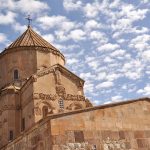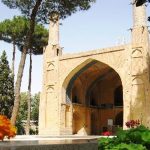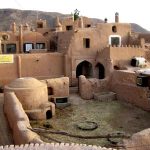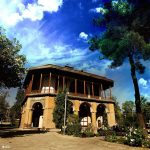Hasht Behesht Palace , Isfahan
Hasht Behesht Palace in Isfahan is a historical palace in Iran .Also, it built during the Safavid era and in 1080/1080. The palace built on two floors in a large garden. Besides, the architectural style of this building is Isfahani style.
In addition, it has seen that in modern and advanced cities, the garden still stands exactly in the center of the city. Besides, one of the characteristics of Hasht Behesht Palace in Isfahan is that its eastern side is the municipality and its western side is the gold market .Also, people go through a lush garden to shortcut the street, something that is less common in today’s cities.
Moreover, one can approach Naghsh-e Jahan Square with a 20-minute walk from Goldasteh Street and then Sepah Street. Also, it is possible to get five minutes from Chahar Bagh Abbasi Street to thirty-three bridges. Besides, there are also many materials around the palace .
Location
Hasht Behesht Palace in Isfahan is one of the most spectacular historical places in the city. Besides, this is another safavid monument located right in the urban fabric of Isfahan .Also, it is actually a flat garden located west of ChaharBagh Street down and reaches the late street from the east.
History of Hasht Behesht Palace
Hasht Behesht Palace, once called the most beautiful palace in the world. Also, it built in 1080 AH and during the reign of Shah Sulayman Safavi. In addition, Isfahan’s first school Hasht Behesht Palace, known as Homayouni School.
In addition, the vast garden located was part of the great garden of Naghsh-e Jahan.Also, Shah Isma’il I built and divided into several pieces during the time of his successors, especially Shah Abbas I.Besides, the Garden of Hasht Behesht existed during the time of Shah Safi. Furthermore, during the next two kings, Shah Abbas II and Shah Sulayman, they added to the trees of this beautiful garden.
Moreover, it should notethat Koshk Bagh belongs to the time of Shah Sulayman Safavi. Also, during that time the garden completed and modified and amended in 1080 AH. Besides, Qaf, which coincided with the third year of shah Sulayman Safavi’s reign completed. In addition, according to some historians, the garden was the living of eight mourners of the King’s Shrine.
Actually, this two-story building with beautiful arches and many decorations is one of the shining examples of Safavid architecture. Also, from the very beginning of the construction of the Hasht Behesht Palace, it called “Eight to Eight” and “Eight in Paradise”.
Architecture
The central part of the Hasht Behesht Palace built in four saffehs and its porch is ahead of the north. In addition, the roof located on the 4-line building and covered with well-designed gypsum mogharns.
Moreover, the first floor rooms in the four corners of the mansion have decorations of plasterboard and painting. Also, there is a collection of luxuries, rooms, arches and windows on the second floor. Besides, this floor divided into several hallways and rooms with special decorations.
In addition, in some ponds, water and some wall heaters embedded. Also, the walls painted with many mirrors. Besides, all the roofs of the palace covered with excellent mosaics. Furthermore, it surrounded by beautiful and harmonious corridors and ghulams.
Actually, what is important in this mansion is the connection emerging between the spaces and the different parts of it. Also, this connection has made the mansion enjoy considerable unity, integrity and decoration.
Actually, one of the main architectural points used in Hasht Behesht Palace. Also, its uniqueness is the way of communication and the link between spaces and corridors. In addition, this connection caused a certain unity and integration to use throughout it. Besides, all of these along with the beautiful decorations in which it has been used, has made this monument one of the top tourist attractions of Isfahan.
Decorations of Hasht Behesht Palace
The Hasht Behesht Palace decorations during the Safavid era have been so magnificent. Also, unfortunately, there is no sign of zarnegar wood fences, frames and cups of crystals and delicate colorful glass penises. So, because many changes have made in the periods after the Safavid era, especially in the Qajar era. Besides, these changes are so much that some travelers have counted it since the Qajar era.
In addition, at the end of the Qajar era, Hasht Behesht Palace privately owned by individuals. Also, the Palace was free of exquisite and precious ornaments of the Safavid era. So, today there is no sign of all the glory and charms inside the palace and the waterfronts and flowing water.
Moreover, it is important to note the decorations of this eight-cornered palace is a sign of the architectural and decorations of Safavid era. Also, along with building located between the gardens, have later greatly imitated.
Why Hasht Behesht Palace?
There are many narratives about the story of the naming of Hasht Behesht Palace in Isfahan. Also, some say Safavid King Sulayman built the mansion for his eight minions. Besides, four of whom lived downstairs and four others upstairs.
Furthermore, it was probably a more important reason for this name. So, it goes back to the octagonal structure and architecture of the palace. That is, it resembles a square that has its angles cut and made the building look like an octagon.
In addition, Hashty in his time meant entering paradise. So, the Palace of Eight Heavens known by other names such as Eight to Eight or Nightingale Garden and Eight in Paradise. Besides, this octagonal mansion has four facades or four angles. Also, none of which are similar to each other and interestingly this variety of coherent composition has not combined.
Moreover, during the Qajar era, part of the palace changed to a school. Also, its administration entrusted to one of the court women during nasir al-din Shah’s reign. Besides, most of the damage to the eight heavens caused by the eyes of the court’s heirs to the palace.
By this Persian travel agency, you’ll get the answer to the question: where is Iran?
Take a look at our Isfahan tour and then travel to Iran with peace of mind.





























